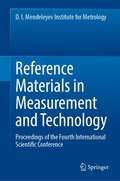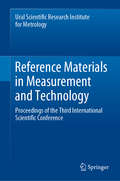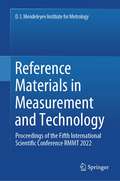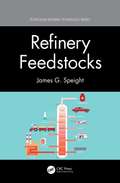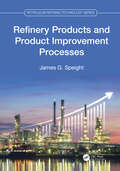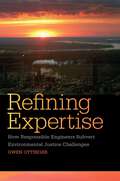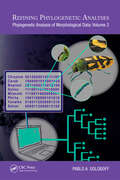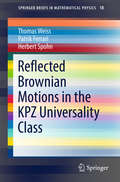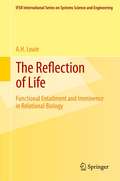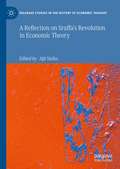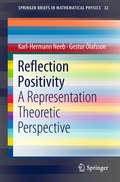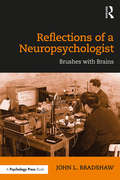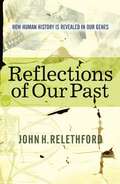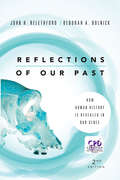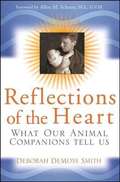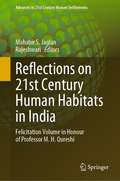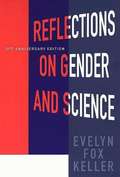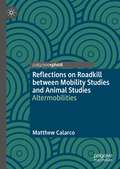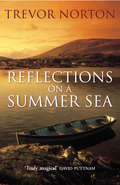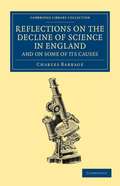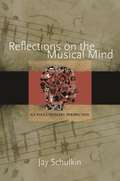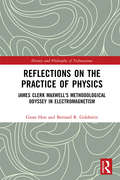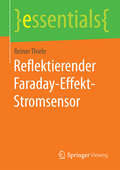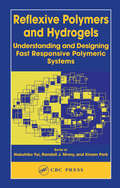- Table View
- List View
Reference Manual on Scientific Evidence: Third Edition
by Committee on the Development of the Third Edition of the Reference Manual on Scientific EvidenceThe Reference Manual on Scientific Evidence, Third Edition, assists judges in managing cases involving complex scientific and technical evidence by describing the basic tenets of key scientific fields from which legal evidence is typically derived and by providing examples of cases in which that evidence has been used. First published in 1994 by the Federal Judicial Center, the Reference Manual on Scientific Evidence has been relied upon in the legal and academic communities and is often cited by various courts and others. Judges faced with disputes over the admissibility of scientific and technical evidence refer to the manual to help them better understand and evaluate the relevance, reliability and usefulness of the evidence being proffered. The manual is not intended to tell judges what is good science and what is not. Instead, it serves to help judges identify issues on which experts are likely to differ and to guide the inquiry of the court in seeking an informed resolution of the conflict. The core of the manual consists of a series of chapters (reference guides) on various scientific topics, each authored by an expert in that field. The topics have been chosen by an oversight committee because of their complexity and frequency in litigation. Each chapter is intended to provide a general overview of the topic in lay terms, identifying issues that will be useful to judges and others in the legal profession. They are written for a non-technical audience and are not intended as exhaustive presentations of the topic. Rather, the chapters seek to provide judges with the basic information in an area of science, to allow them to have an informed conversation with the experts and attorneys.
Reference Materials in Measurement and Technology: Proceedings of the Fourth International Scientific Conference
by Olga N. Kremleva Egor P. Sobina Sergey V. Medvedevskikh Mikhail V. OkrepilovThe book covers in particular state-of-the-art scientific research about product quality control and related health and environmental safety topics, including human, animal and plant safety assurance issues. These conference proceedings provide contemporary information on the general theoretical, metrological and practical issues of the production and application of reference materials.Reference materials play an integral role in physical, chemical and related type of measurements, ensuring their uniformity, comparability and the validity of quantitative analysis as well as, as a result, the objectivity of decisions concerning the elimination of technical barriers in commercial and economic, scientific and technical and other spheres of cooperation. The book is intended for researchers and practitioners in the field of chemistry, metrologists, technical physics, as well as for specialists in analytical laboratories, or working for companies and organizations involved in the production, distribution and use of reference materials.
Reference Materials in Measurement and Technology: Proceedings of the Third International Scientific Conference
by Sergei V. Medvedevskikh Olga N. Kremleva Irina E. Vasil’eva Egor P. SobinaThe book covers in particular state-of-the-art scientific research about product quality control and related health and environmental safety topics, including human, animal and plant safety assurance issues. These conference proceedings provide contemporary information on the general theoretical, metrological and practical issues of the production and application of reference materials.Reference materials play an integral role in physical, chemical and related type of measurements, ensuring their uniformity, comparability and the validity of quantitative analysis as well as, as a result, the objectivity of decisions concerning the elimination of technical barriers in commercial and economic, scientific and technical and other spheres of cooperation. The book is intended for researchers and practitioners in the field of chemistry, metrologists, technical physics, as well as for specialists in analytical laboratories, or working for companies and organizations involved in the production, distribution and use of reference materials.
Reference Materials in Measurement and Technology: Proceedings of the Fifth International Scientific Conference RMMT 2022
by Egor P. Sobina Sergey V. Medvedevskikh Olga N. Kremleva Ivan S. Filimonov Elena V. Kulyabina Anna V. Kolobova Andrey V. Bulatov Vladimir I. DobrovolskiyThe book covers in particular state-of-the-art scientific research about product quality control and related health and environmental safety topics, including human, animal and plant safety assurance issues. These conference proceedings provide contemporary information on the general theoretical, metrological and practical issues of the production and application of reference materials.Reference materials play an integral role in physical, chemical and related type of measurements, ensuring their uniformity, comparability and the validity of quantitative analysis as well as, as a result, the objectivity of decisions concerning the elimination of technical barriers in commercial and economic, scientific and technical and other spheres of cooperation. The book is intended for researchers and practitioners in the field of chemistry, metrologists, technical physics, as well as for specialists in analytical laboratories, or working for companies and organizations involved in the production, distribution and use of reference materials.
Refinery Feedstocks (Petroleum Refining Technology Series)
by James G. SpeightOver the last several decades, the petroleum industry has experienced significant changes in resource availability, petro-politics, and technological advancements dictated by the changing quality of refinery feedstocks. However, the dependence on fossil fuels as the primary energy source has remained unchanged. Refinery Feedstocks addresses the problems of changing feedstock availability and properties; the refining process; and solids deposition during refining. This book will take the reader through the various steps that are necessary for crude oil evaluation and refining including the potential for the use of coal liquids, shale oil, and non-fossil fuel materials (biomass) as refinery feedstocks. Other features: Describes the various types of crude oil and includes a discussion of extra heavy oil and tar sand bitumen Includes basic properties and specifications of crude oil and the significance in refinery operations This book is a handy reference for engineers, scientists, and students who want an update on crude oil refining and on the direction the industry must take to assure the refinability of various feedstocks and the efficiency of the refining processes in the next fifty years. Non-technical readers, with help from the extensive glossary, will also benefit from reading this book.
Refinery Products and Product Improvement Processes (Petroleum Refining Technology Series)
by James G. SpeightThis book focuses on the various refinery products, product improvement processes, and solvent processes that are used in the refining industry and the processes used in product improvement to ensure products meet sales specifications. This accessible book is written for engineers, scientists, students, and academics wanting an update on crude oil processing and insight into the direction of the industry.Key features:• Describes the development of technologies for a variety of feedstocks, including heavy feedstocks utilizing advanced pre-treatment processing and hydrotreating.• Presents the initial refining processes and prepares for the new changes and evolution of the industry, including the role of biomass in the future refinery. • Analyses catalyst deactivation mechanism for developing optimum technologies for processing feedstocks with low reactivity.• Includes an extensive glossary which will be beneficial for non-technical readers.
Refining Expertise: How Responsible Engineers Subvert Environmental Justice Challenges
by Gwen OttingerWinner of the 2015 Rachel Carson Prize presented by the Society for Social Studies of Science Residents of a small Louisiana town were sure that the oil refinery next door was making them sick. As part of a campaign demanding relocation away from the refinery, they collected scientific data to prove it. Their campaign ended with a settlement agreement that addressed many of their grievances--but not concerns about their health. Yet, instead of continuing to collect data, residents began to let refinery scientists' assertions that their operations did not harm them stand without challenge. What makes a community move so suddenly from actively challenging to apparently accepting experts' authority? Refining Expertise argues that the answer lies in the way that refinery scientists and engineers defined themselves as experts. Rather than claiming to be infallible, they began to portray themselves as responsible--committed to operating safely and to contributing to the well-being of the community. The volume shows that by grounding their claims to responsibility in influential ideas from the larger culture about what makes good citizens, nice communities, and moral companies, refinery scientists made it much harder for residents to challenge their expertise and thus re-established their authority over scientific questions related to the refinery's health and environmental effects. Gwen Ottinger here shows how industrial facilities' current approaches to dealing with concerned communities--approaches which leave much room for negotiation while shielding industry's environmental and health claims from critique--effectively undermine not only individual grassroots campaigns but also environmental justice activism and far-reaching efforts to democratize science. This work drives home the need for both activists and politically engaged scholars to reconfigure their own activities in response, in order to advance community health and robust scientific knowledge about it.
Refining Phylogenetic Analyses: Phylogenetic Analysis of Morphological Data: Volume 2 (Species and Systematics)
by Pablo A. GoloboffThis volume discusses the aspects of a phylogenetic analysis that go beyond basic calculation of most parsimonious trees. Practical application of all principles discussed is illustrated by reference to TNT, a freely available software package that can perform all the steps needed in a phylogenetic analysis. The first problem considered is how to summarize and compare multiple trees (including identification and handling wildcard taxa). Evaluation of the strength of support for groups, another critical component of any phylogenetic analysis, is given careful consideration. The different interpretations of measures of support are discussed and connected with alternative implementations. The book reviews rationales for estimating character reliability on the basis of homoplasy, with particular attention to morphological characters. The main methods for character weighting and their practical implementation, several of them unique to TNT, are discussed ad libitum. Also unique to TNT is the ability to directly analyze morphometric data (including landmarks), on the same footing as discrete characters. Finally, the scripting language of TNT is introduced. With scripting, it is possible to "program" TNT to create personalized routines and automate complex calculations, taking analyses to the next level and allowing exploration of new methods and ideas.Key Features Discusses the treatment of ambiguity in phylogenetic analyses in depth, for summarizing results or comparing trees Reviews literature on arguments and methods for weighting morphological characters and their practical application Describes theory and application of methods for evaluating strength of group support, based on either resampling or comparisons with suboptimal trees Discusses the use of morphometric characters in phylogenetic analysis Presents extensive information on commands and options of the TNT computer program, including the use and creation of scripts
Reflected Brownian Motions in the KPZ Universality Class
by Thomas Weiss Patrik Ferrari Herbert SpohnThis book presents a detailed study of a system of interacting Brownian motions in one dimension. The interaction is point-like such that the n-th Brownian motion is reflected from the Brownian motion with label n-1. This model belongs to the Kardar-Parisi-Zhang (KPZ) universality class. In fact, because of the singular interaction, many universal properties can be established with rigor. They depend on the choice of initial conditions. Discussion addresses packed and periodic initial conditions (Chapter 5), stationary initial conditions (Chapter 6), and mixtures thereof (Chapter 7). The suitably scaled spatial process will be proven to converge to an Airy process in the long time limit. A chapter on determinantal random fields and another one on Airy processes are added to have the notes self-contained. These notes serve as an introduction to the KPZ universality class, illustrating the main concepts by means of a single model only. The notes will be of interest to readers from interacting diffusion processes and non-equilibrium statistical mechanics.
The Reflection of Life
by A. H. LouieA. H. Louie's The Reflection of Life: Functional Entailment and Imminence in Relational Biology is a continuation of the exploratory journey in relational biology which began with his 2009 monograph More Than Life Itself: A Synthetic Continuation in Relational Biology. The theme of his first book was 'What is life?'; the theme of this sequel is "How do two life forms interact?" Biology is a subject concerned with organization of relations. Relational biology is the approach that advocates 'function dictates structure", rather than 'structure implies function'. It is mathematics decoded into biological realizations. The book demonstrates some of the powers of the approach of relational biology, and illustrates how pertinent problems in biology can be better addressed this way. In the first volume the theory was developed by using partially ordered sets, lattices, simulations, models, Aristotle's four causes, graphs, categories, simple and complex systems, anticipatory systems, and metabolism-repair [(M,R)-] systems. Here in the second volume, these tools are expanded to employ set-valued mappings, adjacency matrices, random graphs, and interacting entailment networks. The theory of set-valued mappings culminates in the imminence mapping, which equips the further investigation of functional entailment in complex relational networks. Imminence in (M,R)-networks that model living systems addresses the topics of biogenesis and natural selection. Interacting (M,R)-networks with mutually entailing processes serve as models in the study of symbiosis and pathophysiology. The formalism also provides a natural framework for a relational theory of virology and oncology. This book will serve researchers and graduate students in mathematics and biology.
A Reflection on Sraffa’s Revolution in Economic Theory (Palgrave Studies in the History of Economic Thought)
by Ajit SinhaThis book presents a substantial collection of essays from a wide range of well respected scholars addressing several aspects of Piero Sraffa’s economics in light of continuing controversies over the interpretation that should be placed on his work. It moves beyond extant scholarship with an added emphasis on the philosophical dimension of Sraffa’s seminal work, Production of Commodities by Means of Commodities. Contributors probe new ways of thinking about the political economy of Sraffa and in doing so, alongside the comments to each contribution by other scholars, provide a cutting edge debate and discussion on non-mainstream economic theory.This book will be of interest to academics and advanced graduate students in economics, with additional interest from scholars in philosophy and the methodology of science.
Reflection Positivity: A Representation Theoretic Perspective (SpringerBriefs in Mathematical Physics #32)
by Karl-Hermann Neeb Gestur ÓlafssonRefection Positivity is a central theme at the crossroads of Lie group representations, euclidean and abstract harmonic analysis, constructive quantum field theory, and stochastic processes.This book provides the first presentation of the representation theoretic aspects of Refection Positivity and discusses its connections to those different fields on a level suitable for doctoral students and researchers in related fields.It starts with a general introduction to the ideas and methods involving refection positive Hilbert spaces and the Osterwalder--Schrader transform. It then turns to Reflection Positivity in Lie group representations. Already the case of one-dimensional groups is extremely rich.For the real line it connects naturally with Lax--Phillips scattering theory and for the circle group it provides a new perspective on the Kubo--Martin--Schwinger (KMS) condition for states of operator algebras. For Lie groups Reflection Positivity connects unitary representations of a symmetric Lie group with unitary representations of its Cartan dual Lie group.A typical example is the duality between the Euclidean group E(n) and the Poincare group P(n) of special relativity. It discusses in particular the curved context of the duality between spheres and hyperbolic spaces. Further it presents some new integration techniques for representations of Lie algebras by unbounded operators which are needed for the passage to the dual group. Positive definite functions, kernels and distributions and used throughout as a central tool.
Reflections of a Neuropsychologist: Brushes with Brains
by John L. BradshawReflections of a Neuropsychologist: Brushes with Brains follows the life of an influential neuropsychologist's fascinating and varied career. Unique in its autobiographical approach, it features coverage of research into human evolution, archaeology and neurology. Beginning with his earliest memories (and implications for memory processes), John L. Bradshaw reflects on his archaeological expeditions preceding his primary career as a physiological psychologist and a behavioural neuroscientist. His influential research covers such rare neurological disorders as Huntington’s disease, Friedreich ataxia and Williams syndrome, and more common maladies like Parkinson’s and Alzheimer’s diseases, stroke, Fragile X, Tourette’s syndrome, obsessive compulsive and attention deficit hyperactivity disorders, schizophrenia, autism and depression. His fascinating personal experiences illustrating scientific discoveries will entertain, enthuse, encourage and inspire, and provide established research scientists and practising clinicians with a unique road map.
Reflections of Our Past: How Human History is Revealed in Our Genes
by John H. RelethfordAn accessible and absorbing examination of how the genes of living people reveal the history of humankind, from the origins of humans 6 million years ago to the present
Reflections of Our Past: How Human History is Revealed in Our Genes (2nd Edition)
by John H. Relethford Deborah A. Bolnick<p>The rise of the multi-billion dollar ancestry testing industry points to one immutable truth about us as human beings: we want to know where we come from and who our ancestors were. John H. Relethford and Deborah A. Bolnick explore this topic and many more in this second edition of <i>Reflections of Our Past</i>. <p>Where did modern humans come from and how important are the biological differences among us? Are we descended from Neandertals? How should we understand the connections between genetic ancestry, race, and identity? Were Native Americans the first to inhabit the Americas? Can we see evidence of the Viking invasions of Ireland a millennium ago even in the Irish of today? <p>Through engaging examination of issues such as these, and using non-technical language, <i>Reflections of Our Past</i> shows how anthropologists use genetic information to suggest answers to fundamental questions about human history. By looking at genetic variation in the world today and in the past, we can reconstruct the recent and remote events and processes that have created the variation we see, providing a fascinating reflection of our genetic past.</p>
Reflections of the Heart: What Our Animal Companions Tell Us
by Deborah Demoss SmithIn introducing these 20 stories about the extraordinary human-animal bond, a veterinarian explains how he became a convert to believing in the flower essence-enhanced skills of animal intuitive Sharon Callahan. A journalist traces how Callahan came to be aware of her ability, and collects case stories about how pets purportedly communicated with their human companions through Callahan. Resources listed include holistic veterinarians, and grief and loss support Web sites. Annotation ©2004 Book News, Inc., Portland, OR (booknews.com)
Reflections on 21st Century Human Habitats in India: Felicitation Volume in Honour of Professor M. H. Qureshi (Advances in 21st Century Human Settlements)
by Mahabir S. Jaglan RajeshwariThis book highlights various dimensions of human habitats in 21st Century India. The human habitats in the country are marked by perceptible inequality in social and economic spheres. This is occurring in tandem with rapid socio-economic transformation across both rural and urban landscapes. There is a plurality of transformative characteristics in terms of social and economic classes, gender and space. Inequality in access to natural resources such as land and water is still a big factor in socio-economic differentiation in rural habitats. This constructs a pedestal of unequal opportunities and access to basic human necessities such as healthcare, education, potable water and sanitation. Human habitats experiencing socio-spatial segregation and exclusion based on caste, community and gender are detrimental in formation of a civil society and its sustainability in long terms. The ideal situation for this would be formation of an inclusive society that celebrates age old socio-cultural diversities, reduces inequalities and reveres composite culture.
Reflections on Gender and Science
by Evelyn Fox KellerThis groundbreaking work explores the possibilities of a gender-free science and the conditions that could make such a possibility a reality.
Reflections on Roadkill between Mobility Studies and Animal Studies: Altermobilities
by Matthew CalarcoRoadkill is a recurrent but often unthought feature of modern life. Yet, consideration of the broader significance of the myriad social, ethical, and political issues related to roadkill has largely gone missing from mainstream scholarship and activism. This neglect persists even in fields such as mobility studies and animal studies that would otherwise seem to have a vested interest in the topic. This book aims to bring roadkill to the foreground of current discussions among scholars and activists in these fields in order to demonstrate that roadkill is a uniquely important site from which to understand and contest the machinations of the dominant social order. It argues that a careful examination of roadkill can help both to uncover the hidden violence of contemporary human-centered systems of mobility and to develop alternative modes of mobility for a renewed social life in common with our more-than-human kin.
Reflections On A Summer Sea
by Trevor NortonThis is the funny and touching story of a menagerie of eccentric and talented ecologists who, mainly as a hobby, spent forty summers at Lough Ine, a stunning marine lough in a corner of Ireland, where myths seep from the ground like will o' the wisps and, in one of the most unlikely projects in the history of science, were responsible for the reinvention of marine biology. Among the stars of the book are the marine creatures that occupy the lake: sea urchins that won't dine unless they wear a hat, otters that steal experiments, and worms that will only mate by order of the moon. The creatures' eccentric behaviour is matched only by that of the ecologists themselves, whose antics and interactions with their Irish neighbours are all lovingly described with Norton's keen eye for both the wonderful and the absurd. But for all its humour, the book is also a moving account of two ecologists who collaborated for forty years until their friendship came to a tragic end. The book brings together all the rich flavours of Ireland, the wonders of natural history and the magic of being a marine biologist just for the fun of it.
Reflections on the Decline of Science in England, and on Some of Its Causes
by Charles BabbageThe mathematician Charles Babbage (1791-1871) was one of the most original thinkers of the nineteenth century. In this influential 1830 publication, he criticises the continued failure of government to support science and scientists. In addition, he identifies the weaknesses of the then existing scientific societies, saving his most caustic remarks for the Royal Society. Asserting that the societies were operated largely by small groups of amateurs possessing only superficial interest and knowledge of science, Babbage explores the importance of the relationships between science, technology and society. Exposing the absence of a true scientific culture, he states, 'The pursuit of science does not, in England, constitute a distinct profession, as it does in other countries. ' These concerns found favour with many, influencing reforms of the Royal Society and leading to the founding of the British Association.
Reflections on the Musical Mind: An Evolutionary Perspective
by Jay SchulkinWhat's so special about music? We experience it internally, yet at the same time it is highly social. Music engages our cognitive/affective and sensory systems. We use music to communicate with one another--and even with other species--the things that we cannot express through language. Music is both ancient and ever evolving. Without music, our world is missing something essential.In Reflections on the Musical Mind, Jay Schulkin offers a social and behavioral neuroscientific explanation of why music matters. His aim is not to provide a grand, unifying theory. Instead, the book guides the reader through the relevant scientific evidence that links neuroscience, music, and meaning. Schulkin considers how music evolved in humans and birds, how music is experienced in relation to aesthetics and mathematics, the role of memory in musical expression, the role of music in child and social development, and the embodied experience of music through dance. He concludes with reflections on music and well-being. Reflections on the Musical Mind is a unique and valuable tour through the current research on the neuroscience of music.
Reflections on the Practice of Physics: James Clerk Maxwell’s Methodological Odyssey in Electromagnetism (History and Philosophy of Technoscience)
by Giora Hon Bernard R. GoldsteinThis monograph examines James Clerk Maxwell’s contributions to electromagnetism to gain insight into the practice of science by focusing on scientific methodology as applied by scientists. First and foremost, this study is concerned with practices that are reflected in scientific texts and the ways scientists frame their research. The book is therefore about means and not ends.
Reflektierender Faraday-Effekt-Stromsensor (essentials)
by Reiner ThieleReiner Thiele hat durch die Applikation des Faraday-Effektes zur Polarisations-Ebenen-Drehung linear polarisierten Lichts in Lichtwellenleitern, induziert durch das den stromführenden elektrischen Leiter umgebende Magnetfeld, eine Lösung gefunden, hohe elektrische Ströme ohne Eingriff in den Messgrößenkreis zu messen. Dies stellte bisher ein grundsätzliches Problem der elektrischen Energietechnik dar. Eine in Reflexion arbeitende erfindungsgemäße Schaltungsanordnung aus optischen und elektronischen Komponenten stellt dabei den gewünschten linearen Zusammenhang zwischen Messgröße und Messwert bei Elimination der störenden Doppelbrechung der Lichtwellenleiter her, die sich ansonsten vermindernd auf die Effizienz des Faraday-Effektes auswirkt.
Reflexive Polymers and Hydrogels: Understanding and Designing Fast Responsive Polymeric Systems
by Nobuhiko Yui Randall J. Mrsny Kinam ParkDespite their capacity to carry out functions that previously were unobtainable, smart polymers and hydrogels tend to have painfully slow response times. On the other hand biological systems go through phase changes at an extremely fast rate. Reflexive Polymers and Hydrogels examines the natural systems that respond almost instantaneously to environmental stimuli, and thus gives the reader an understanding of the mechanisms that govern these responses. The book includes chapters on approaches and procedures for designing a synthetic ...flash... system based on naturally occurring systems. It also deals with some of the promising potential applications of flash systems in industry.

